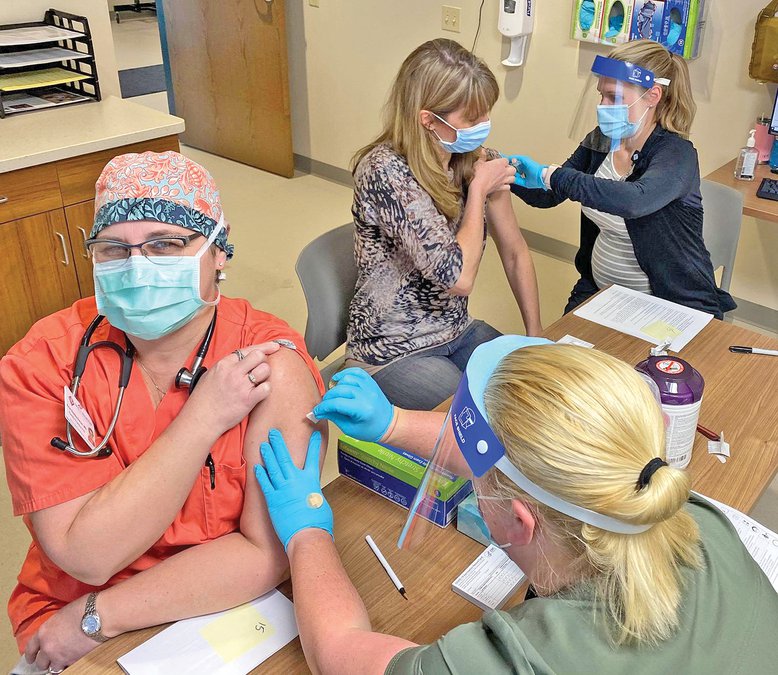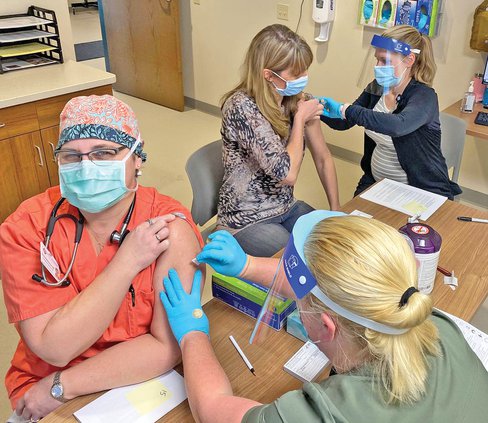By David Timmerman
newseditor@tds.net
As the calendar is about to turn, so to may be the page turning on the COVID-19 pandemic, as the first batches of the coronavirus vaccine are rolling into southwest Wisconsin.
Grant Regional Health Center received its first shipment of Moderna vaccine Monday morning, and began immunizing 103 frontline staff during the mornings at the start of the week.
Dr. Erin Huebschman and Dr. Kim Perttu were the first staff members to roll up their sleeves and be immunized.
“It really felt like any other shot,” Huebschman shared on the physical feeling, but added that in the minds of those getting the shot, it was something more. “The excitement in the education center was palpable as Dr. Kim Perttu and myself were the first to get the vaccine as the trailblazers for GRHC to test out the vaccination process that includes screening questions and consent to receive the vaccine,” Huebschman stated.
When getting the vaccine, there is a monitoring period of 15-30 minutes to make sure that there is not an allergic reaction. That review of these vaccines, which were approved for emergency use due to the severity of the pandemic, continue on as those who receive the vaccine are asked to sign up for V-safe on their smartphones, which is a CDC monitoring program that checks on the immunized individual at set intervals to monitor for potential side effects.
Grant Regional received the Moderna vaccine, which along with another vaccine created by Pfizer, was approved earlier this month. Rural areas like Grant County are more likely to get the Moderna version because that does not require the ultra cold storage the Pfizer one does.
Those who received the dose this week will have to return in 28 days for a second dose, as both approved vaccines require two doses.
The hospital received 100 doses, but as is common with medicines and vaccines, there is some additional product in the vials, which is there to compensate for material that may be not fully utilized, that amount did not cover all the frontline individuals, as there are about 70 more who would like to be vaccinated that are considered frontline.
Grant Regional and other healthcare providers are working with the Wisconsin Department of Health Services, which is overseeing the distribution of the vaccines in the state, and setting up the guidelines of who is a priority first.
“The vaccination team worked hard to work through all the logistical issues to plan for the vaccination clinic,” Huebschman said of just handling the Grant Regional staff. “We know that when it comes time to provide vaccines to the public that there will be considerable challenges to overcome as the country hopes to mobilize this massive vaccination effort in the future.”
Huebschman advised the public that may be interested in getting the vaccine when it becomes available to the public to keep an eye on the local news and social media regarding future vaccination clinics, as institutions like Grant Regional are not creating waiting lists.
Because of its limited rollout, individuals are still encouraged to keep wearing masks, washing hands and maintain social distancing, as these are effective in reducing your chances of getting COVID-19, which is especially important due to the fact that the new variant that can spread more easily has been found in the United States.
Huebschman added that while things are going in the right direction, people should still get tested so that community spread can be kept track of, and that individuals are not being spreaders. “I would encourage people not to just think that they have a ‘cold’ right now, but if you have respiratory symptoms, aching, fever, or even diarrhea, that you should be tested at one of the community testing sites.”





